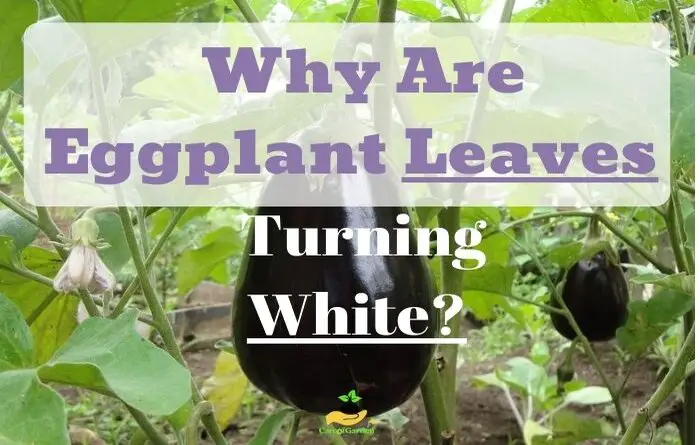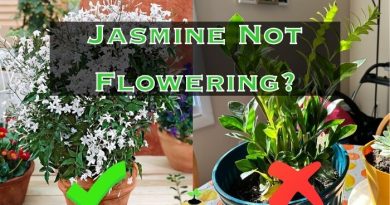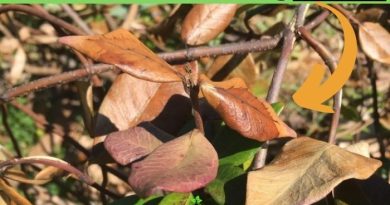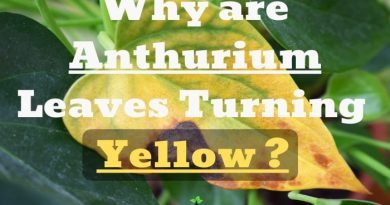Why Are Eggplant Leaves Turning White? (6 Must See Causes)
The causes of white spots on eggplant leaves are varied and in this article we will discover the reasons why eggplants leaves are turning white!
Such damage can be caused by both diseases and pests. Therefore, before you start to get nervous, inspect the leaves and stems well for the presence of any bugs, spiders, egg-laying, aphids and other living creatures.
If everything is in order and no traces of the pest are found, then eggplant leaves turn white because of excess light, a sunburn appears from additional lamp lighting or direct sunlight.
Protecting eggplant seedlings is quite simple, shade plantings with newspapers or gauze. Also, white spots on leaves can occur from sudden changes in temperature or when it drops below 50°F (10 °C).
| Causes of Eggplant Leaves Turning White |
|---|
| 1. Sunburn |
| 2. Cold water |
| 3. Excess fertilizer |
| 4. Powdery mildew |
| 5. Whitefly |
| 6. Aphids |
Causes of Eggplant Leaves Turning White
1. Sunburn
Eggplant seedlings are quite sensible to light and the primary cause the eggplant leaves turn white is sunburn, especially when watering the seedlings in sunlight and over the leaves, which is absolutely impossible to do.
Knowing the light-loving nature of vegetable crops, most vegetable growers try to put containers with seedlings in the sunniest place. As a result, white spots of small sizes appear on the leaves of eggplant, which can merge into one large one.
This is how ultraviolet rays burn. Its leaves can be obtained not only from the sun, but also from a Phyto-lamp, which is often used to illuminate plants in early spring.
Eggplants are demanding of light. Therefore, even at the stage of growing seedlings, it is necessary to install LED Phyto-Lamp. After transplanting into the greenhouse, it is better to shade the open ground eggplant seedlings a little.
If the weather is too hot, too much sunlight can cause the leaves of an eggplant to turn white. Therefore, gardeners usually install a canvas of light materials or protective screens.
If white spots appear on the leaves of eggplant seedlings, then pay attention to the lighting and provide eggplants with:
- Long daylight hours (12 hours);
- Diffused light (not direct rays).
2. Cold water
The second reason why white spots appear on the leaves of eggplant, is because of watering with cold water. Eggplant can only get nutrients from well-warmed soil. Eggplant seedlings should be watered with water at room temperature.
Otherwise, the root system of plants gets stressed, and the plants receive less organic and mineral components. Their development stops, and white patches appear on the leaves.
Watering with cold water , which the root system is not able to absorb. The soil after watering is damp, but water has not entered the stems and leaves, therefore white spots appear on leaves and the leaves start to fade.
To prevent white spots from the sun on the leaves, do not allow drops of water to fall on them. They will play the role of a lens.
Especially if, when watering, drops of water fell and remained on the leaves, after which direct sunlight shone on them. Like a lens, the water droplets burned and whitened these areas. Avoid such cases if you want to keep eggplants healthy.
You can prevent white spots on eggplant seedlings by properly watering the plants:
- Use warm water when watering the eggplants.
- Don’t pour water on the eggplants leaves in the middle of the day.
Since they are in the same place, the substrate and water will have the same temperature – this will save the eggplants from stress.
Does your pepper leaves also turn white? I have the solution to the problem in this article!
3. Excess fertilizer
Another reason why eggplants leaves turn white is the excess fertilizer used. Eggplants need regular feeding, which is applied literally every 2-3 weeks. In fact, with an excess of minerals (potassium compounds, superphosphates, trace elements), the soil begins to acidify.
As a result, the acidity index pH changes, due to which the root system absorbs nutrients much worse. Therefore, plants lag behind in development, the leaves are turning white and becoming smaller.
Do not abuse frequent top dressing. If the seedlings look healthy, then fertilizers are applied no more than 3 times during its cultivation.
In this case, you need to carefully study the instructions for using any drug, and prepare the solution with special attention. Do not increase the concentration of the fertilizer, because excess nitrogen also cause the appearance of spots on the eggplant leaves.
If the roots are damaged, the seedlings begin to noticeably lag behind in growth and change the color of the leaf plates.
For example:
- with zinc deficiency, a whitish coating forms on the eggplant upper leaves;
- with a lack of copper in eggplant seedlings, the tips of the leaves turn white;
- with a lack of potassium, then a yellow-brown border appears on the leaves, and the leaf plates themselves may acquire a whitish color.
However, more often white spots appear as a result of exposure to fungal diseases and pests, whose spores or larvae can persist in the soil for a long time.
If your cabbage leaves are turning yellow, here are the measures you should take to combat this!
4. Powdery mildew
One of the most common fungal diseases of the eggplant, caused by the fungi of the genus Oidium, takes the name of powdery mildew. It infests eggplants leaves and shoots which will cause the appearance of white spots on it’s leaves.
The white disease or powdery mildew affects the leaves, shoots and fruits, first causing the appearance of a whitish patina, with a floury and dusty appearance; then the affected leaves dry out. The fruits have a stunted development or a greyish felt that covers them, making them inedible.
Also, the eggplant foliage turns white due to powdery mildew. The main symptom of the disease is the appearance of a white powdery coating on the surface of leaves and stems.
Small white dots appear on the eggplant leaves , then the fungus invades the lower and upper surfaces of the leaves with a white micellar felt. The leaves dry up prematurely.
How to prevent appearance of powdery mildew on eggplants
- Do not plant too tightly to ensure good ventilation between eggplants.
- Choose resistant varieties.
- Avoid fertilizers that are too rich in nitrogen.
How to treat Powdery mildew
- Carefully remove diseased eggplant parts.
- Treat eggplants leaves with a spray of horsetail decoction diluted to 20%.
- Spray manure or horsetail decoction, alternate with Bordeaux mixture.
- Remove affected leaves as soon as the first symptoms appear.
5. Whitefly
It is the most common pest of eggplants. They are small insects that fly and below the eggplant leaves you can see their eggs in the form of white circles and white dots.
Whiteflies feed on the sap contained in the leaves, especially on the underside causing a slowdown in the development of eggplants, which lead to whitening of their leaves . If no measures are taken, they will cause their development to stop and the eggplant will be lost.
In addition, they are capable of secreting sticky molasses (honeydew secretions), so there will be more chances that fungi will begin to attack the eggplant in turn. As a consequence, the fruit will rot and the leaves will reduce their ability to carry out photosynthesis.
How to treat whitefly
Whitefly pests are among the most complicated to control due to their ability to reproduce and their life cycle.
Using a water hose, try to blast away whiteflies and wash them off your eggplants leaves. Then rub insecticidal soap on the underside of your eggplant leaves.
Additionally, you can use yellow sticky traps to attract and capture whiteflies.
6. Aphids
Aphids are small soft-bodied insects that settle on the undersides of eggplant leaves or stems. They weaken the eggplant by sucking its sap which will lead to a discoloration on the leaves.
They are fairly easy to spot, and the punctures they make in the leaf tissue cause the leaves to get a whitish-yellow color and to become sticky due to the honeydew that these parasites excrete that encourages sooty mold growth on plants.
If the aphid infestation is heavy, it can cause leaves to turn yellow and distort, necrotic spots on the leaves and/or stunted shoots.
The best remedy for eggplant aphids is prevention. A healthy plant has sufficient protective mechanisms.
Therefore, make sure that your plants are healthy and strong and grow under perfect conditions, because only healthy plants have sufficient protective mechanisms to defend themselves against insects, pests and other diseases.
Nettle slurry is one of the fundamentals of the garden and is that in addition to helping us fight aphids, it also helps us fight fungi and not only that, but also if we use it to water, it strengthens the plant against pests.
How to prevent Eggplant Leaves from Turning White
Here are the steps to prevent eggplant leaves from turning white:
- Shade the eggplant or move it to a dark place. Such actions are necessary if transparent or white formations appear due to sun scorch.
- Regulate temperature. It will require the construction of a mini greenhouse or greenhouse.
- Monitor water temperature for irrigation. Water with water at room temperature, trying not to pour it on the leaves. The most efficient use of water is 22-23°C.
- Get rid of excess moisture (when growing eggplant in a greenhouse) by ventilation.
- Treat the eggplant with a weak solution of potassium permanganate. This method is effective when plantings are oversaturated with top dressings.
- Periodically carefully examine the eggplant seedlings and carry out top dressing.
- Before sowing seeds, the soil and eggplant seeds are recommended to be disinfected;
- So that the leaves are not white, observe the planting density, leaving a minimum distance of 35 cm between the eggplants.
| Eggplant Disease/Pests | Symptoms | How to treat |
|---|---|---|
| Powdery mildew | White spots develops on the eggplant leaves and stems. | Do not require treatment, but rather monitoring and elimination of the affected parts. |
| Aphids | White spots present on the tops of shoots and the undersides of leaves. | Treat with black soap sprays or let the natural predator (ladybug) regulates the population of aphids. Aphids can be dealt with with wood ash or garlic infusion |
| Whiteflies | White spots under the leaves and fly away in small clouds as soon as the eggplant is shaken | Water the eggplants with a insecticidal soap. Carry out a preventive treatment on eggplants with soybean oil and linseed oil to clean, protect and strengthen the plants. |
| Mildew | Appearance of greenish to brownish spots on the eggplants upper side of the leaves and the development of white to gray fluff on the lower side, the leaves of the eggplant turn yellow and dry. | Remove affected eggplants as soon as the first symptoms appear. Preventively treat with sprays of horsetail decoction or Bordeaux mixture. |
| Botrytis (gray rot) | The leaves, stems and even the fruits bear cankers covered with whitish to gray down. | The soil of the vegetable garden must be perfectly drained. Quickly remove the affected parts. Do not wet the foliage when watering. |
Conclusion
Eggplant leaves turn white, usually due to improper care. Plants are quite demanding, so you need to create suitable conditions for them at all stages, from seedlings to harvesting fruits.
White spots on eggplants are an unpleasant phenomenon that does not add optimism to vegetable growers. However, in this article we have shown many ways how to avoid white leaves occurrence on eggplants.
The white disease or powdery mildew affects the leaves, shoots and fruits, first causing the appearance of a whitish patina, with a floury and dusty appearance. Then the affected parts take on a bronze color and dry up, the fruits have a stunted development or a greyish felt that covers them making them inedible.
Leaf wilt is a common problem in eggplant cultivation . It is associated with improper care of a capricious crop (insufficient shading of plantings, frequent watering, excess fertilizer, inappropriate soil composition ) and disease.




